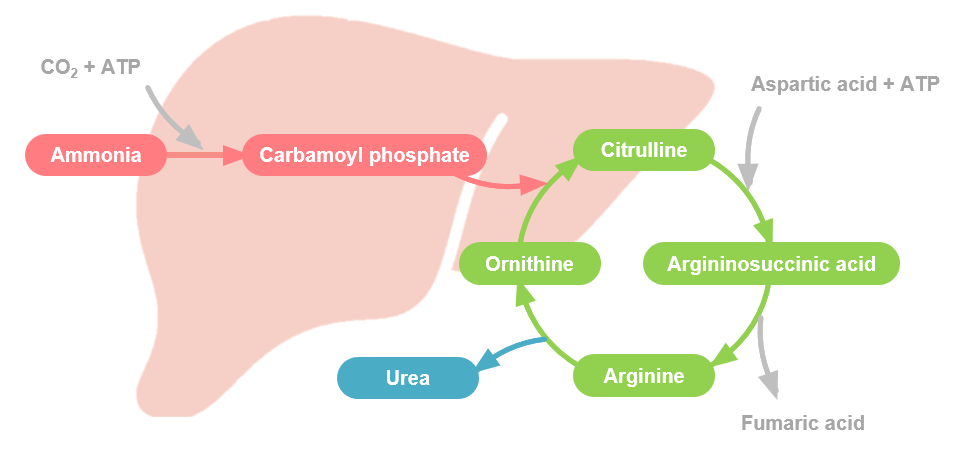Ammonia Assay Kits
Ammonia is converted into urea in the liver through the ornithine cycle and is excreted in the urine via the kidneys. By measuring the ammonia in the blood, liver function can be assessed.
LabAssay™ Ammonia is a kit used for the determination of ammonia in samples using the modified Fujii-Okuda method. With the use of a microplate, this kit provides a quick and convenient method for measuring ammonia in samples.
What is Ammonia?
Ammonia is primarily produced in the liver, kidneys, and intestines, with much of it resulting from the breakdown of amino acids. Since ammonia is a substance harmful to the body, it must be detoxified rapidly. While much of the generated ammonia is recycled, a portion of it is converted into urea and excreted in the urine via the kidneys.
In mammals, ammonia is converted into urea by the ornithine cycle (urea cycle) in the liver (Figure 1). By measuring the ammonia in the blood, liver function can be assessed. In particular, blood ammonia levels tend to be high in cases of severe liver disease.

Methods of Ammonia Measurement
Fujifilm Wako’s Lab Assay™ Ammonia is based on the modified Fujii-Okuda method1). This method utilizes the Berthelot reaction that produces indophenol2). With this kit, ammonia can be conveniently measured using a microplate.
Principle of the Ammonia assay using modified Fujii-Okuda methods
By adding a protein remover solution to the sample, interfering substances for the color reaction are removed, and various enzymes in the sample are inactivated at the same time. Phenol and the reaction catalyst, sodium pentacyanonitrosylferrate(III) (sodium nitroprusside), are added to the supernatant. After making the solution alkaline, oxidation with sodium hypochlorite produces indophenol, which exhibits a blue color. The concentration of ammonia nitrogen in the sample can be determined by measuring the absorbance of the blue color (Figure 2).

LabAssay™ Ammonia
LabAssay™ Ammonia is a kit used for the determination of ammonia in samples using the modified Fujii-Okuda method. With the use of a microplate, this kit provides a convenient method for measuring ammonia in samples.
[Note] LabAssay™ series are reagents for research purposes. They cannot be used for diagnostic purposes.
Kit Performance
| Analysis sample | Human Whole blood Mouse Whole blood Rat Whole blood Dog Serum/Plasma Cat Serum/Plasma Cell culture supernatants* |
|---|---|
| Calibration curve range | 100-400 μg/dL |
| Sample volume | 70 μL |
| Measurement duration | Approx. 70 min |
| Wavelength | 630 nm |
*Measurement availability depends on the culture medium, when using cell culture supernatant as a sample, please make sure to perform recovery test and dilution linearity test on the culture medium before use.
References
- Okuda, H. and Fujii, S.: The Medical Frontline, 21, 622(1966). (Japanese)
- Nambara, T.: Bunseki Kagaku, 16(1), 86(1967).
臨床化学分析に用いる呈色反応の機構 (Japanese)
Product List
- Open All
- Close All
LabAssay™ Ammonia
For research use or further manufacturing use only. Not for use in diagnostic procedures.
Product content may differ from the actual image due to minor specification changes etc.
If the revision of product standards and packaging standards has been made, there is a case where the actual product specifications and images are different.
The prices are list prices in Japan.Please contact your local distributor for your retail price in your region.



